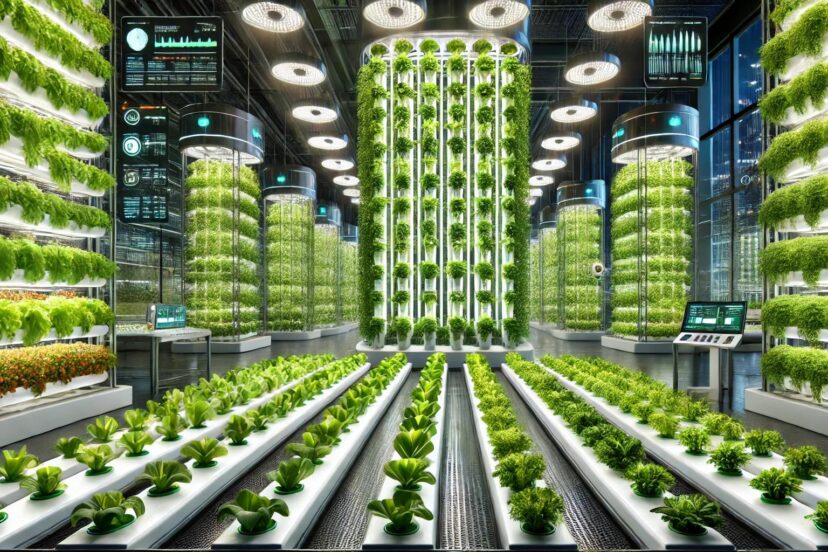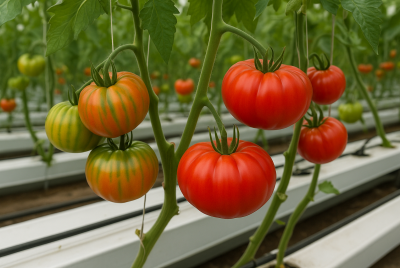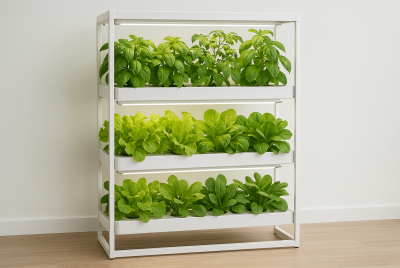Hydroponics Hydroponic Systems: Soil-Free Farming
We may earn a commission for purchases made using our links. Please see our disclosure for more details.
Are you a green thumb enthusiast looking for a new way to grow herbs and lettuce? You’ve come to the right place! Imagine picking fresh herbs straight from your home all year round. Isn’t that good? Hydroponics hydroponic systems are changing the game for home growers and commercial enterprises. In this guide, you’ll learn how growing crops without soil is revolutionary.
What is Hydroponics?
First things first, hydroponics is a method of growing plants using nutrient solution water. No soil is needed. Unlike traditional soil gardening, plants no longer need to search through the dirt just to get the essential nutrients they need to thrive. They get their food directly from the roots. And what does this mean? Meaning, you can be sure that they grow healthy and fast. Oh, and they offer higher yields too. Plus, hydroponics uses 90% less water which is good for sustainability.
How Does a Hydroponic System Work?
The concept of hydroponics is pretty simple. Hydroponics hydroponics systems provide the right mix of water, nutrients, and oxygen. All are controlled with precision. No need to worry about unpredictable weather (that can ruin your growing babies) or over-watering. Plants are regularly flooded with nutrient solution water. It’s farming with the kind of care you’d give to a newborn—constant attention but without the guesswork.

Why Choose Hydroponics?
– Faster growth: Your plants will grow 30-50% faster than their soil-bound cousins.
– Water conservation: You’ll save up to 90% more water—yes, you heard that right.
– Space-efficient: Vertical farming, compact setups… it’s like city living for plants.
Types of Hydroponic Systems
1. Wick System
This system uses a cotton or nylon wick. This way, plants can get the nutrients by slowly sipping through the cotton on the containers or trays. It’s simple, steady, and great for beginners.
2. Deep Water Culture (DWC)
From the term itself, the plant’s roots are suspended in a well-oxygenated nutrient-rich water solution. It works best for small and lightweight crops like lettuce.
3. Nutrient Film Technique (NFT)
NFT is an active hydroponic system. Why? It uses pumps to create a thin stream of nutrients flowing over the roots. It’s my favorite hydroponic system among all of them!
4. Ebb and Flow System
Imagine a rhythmic rise and fall of the ocean tides. That’s pretty much it! This system floods the plants with nutrients and then drains them (periodically), allowing the roots to breathe.
5. Aeroponics
Aeroponics is like the cousin of hydroponics. Instead of dipping the roots in water, this method only mist your plants with a fine spray of nutrients.
Choosing the Right Hydroponic System for You
Not all hydroponic systems are created equal, and choosing the right one depends on several factors:
– Space: Tight on space? NFT or vertical systems could be your new best friends.
– Budget: On a shoestring budget? Wick or DWC systems are cost-effective and easy to maintain.
– Plant preference: Leafy greens love aeroponics, while tomatoes prefer the ebb and flow of nutrients.
Choosing your system is like choosing a new home for your plants—consider what they’ll need to thrive, and go from there.
Hydroponic Growing Mediums: Replacing Soil with Science
Since there’s no soil in hydroponics, you’ll need something to hold your plants in place. Enter the growing mediums, which replace dirt with science:
– Rockwool: Lightweight and moisture-retentive, it’s perfect for hydroponic setups.
– Clay pellets: These reusable balls provide excellent air circulation for your plants’ roots.
– Perlite: Derived from volcanic material, perlite ensures your plants aren’t sitting in water too long.
– Coco coir: Made from coconut husks, it’s a sustainable option that your plants will love.
Setting Up Your Hydroponic Garden: Step-by-Step
1. Choose your system: Start with something simple if you’re new to the game.
2. Prepare your reservoir: Fill it with water and nutrients—think of it as preparing a feast for your plants.
3. Plant your seeds: Place your seedlings in the growing medium, where they’ll settle in.
4. Monitor the environment: Ensure your plants get the right light, temperature, and humidity.
5. Maintain nutrient levels: Keep an eye on your nutrient solution—it’s the lifeblood of your system.
Lighting Matters: Sunlight or Artificial Lights?
Let’s get things straight here… Not because we’re only using water means your plants don’t need sunlight. They still need natural light to thrive! But what I like about hydroponics hydroponic systems is they offer a way to play Mother Nature. Don’t have access to natural light? No problem, you can use LED grow lights instead. No need to worry that your plants will wither when growing indoors!
Maintaining a Healthy Hydroponic System
Once you’re up and running, it’s all about maintenance. Keep an eye on these essentials:
– pH levels: Your plants will thank you for maintaining a pH between 5.5 and 6.5.
– Algae prevention: Cover your water reservoirs to prevent unwanted growth.
– Equipment cleaning: A clean system means happy, healthy plants.
Products to Consider
- iDOO Hydroponics Growing System
A compact hydroponic system with 7 pods, featuring adjustable LED lights and water circulation. Ideal for herbs, flowers, and small vegetables, it ensures continuous growth throughout the year. - Aerospring Indoor Vertical Garden
A vertical hydroponic system designed to maximize space, equipped with LED grow lights and an app-based monitoring system. This setup supports various plants and fits well in limited indoor spaces. - Hydrofarm Root Spa DWC System
A deep-water culture hydroponic system with 5-gallon individual buckets. It includes air pumps for oxygenating roots, ideal for larger crops like tomatoes and peppers. - VIVOSUN NFT Hydroponic Grow Kit
A nutrient film technique system designed for growing leafy greens and herbs. It features PVC grow channels, a water pump, and a nutrient reservoir, ensuring consistent water flow to the roots. - Tower Garden FLEX
A vertical hydroponic system capable of growing up to 20 plants at once. It includes a water reservoir, pump, and grow lights, making it versatile for both indoor and outdoor gardening.
The Benefits of Hydroponic Farming
Recent research underscores the numerous advantages of hydroponic systems for sustainable agriculture. Hydroponics enhances crop yields, minimizes water usage by up to 90%, and supports urban farming through space-efficient vertical setups, as highlighted in a study by the Journal of Student Research. Additionally, insights from ScienceDirect’s topic on hydroponics reveal the potential of controlled environments to reduce the need for pesticides and ensure year-round crop production. Together, these studies emphasize hydroponics as a viable solution to food security challenges, offering a sustainable, resilient farming method suitable for both urban and rural settings.
Challenges to Consider
I’m not gonna lie, hydroponics hydroponic systems have their own challenges. But that’s all part of the journey! Initial costs can be high (depending on which system you’ll use), and you’ll need to rely on electricity to keep things running. But growing fresh plants year-round in the comfort of your home? That makes everything worth the coin.
Hydroponics for Beginners: Start Small, Dream Big
When I started my hydroponics journey, I didn’t go with big hydroponics setups. I started with growing simple plants like lettuce and herbs. Those are my first crops since they’re quite easy to maintain and after all, I’m still learning. Now, I’m trying to grow tomatoes, which may require some level of experience. So just like me, if you’re a newbie, you better grow easier crops at first and master the art of hydroponics before jumping into larger, more delicate plants.
Advanced Hydroponics: Beyond the Basics
Ah, so you think you’ve nailed the basics? Good! It’s time to challenge your green thumb capabilities and try growing tomatoes or peppers. Feeling adventurous? Explore vertical farming! How about aquaponics? Don’t stop learning and growing, folks!
Summary
Hydroponics hydroponic systems are changing gardening in a good way. By being in control of the plant’s environment, you can now make sure your growing plants thrive and are healthy. It doesn’t matter whether you have a green thumb or not, anyone can grow fresh produce all year round. Choose the system for your needs and start your hydroponics journey today!
FAQs
1. What is the best hydroponic system for beginners?
The Deep Water Culture (DWC) system is one of the simplest setups for beginners. It’s affordable, easy to maintain, and doesn’t require much effort.
2. Can I grow any plant with hydroponics hydroponic systems?
Sure! You can grow everything from lettuce and herbs to tomatoes and peppers depending on your level!
3. How often should I swap out the nutrient solution?
Change the nutrient solution every two to three weeks to keep your plants healthy and thriving.
4. Do hydroponic systems require a lot of electricity?
Not really. Simpler setups, like the wick system, use no electricity at all. It depends on the complexity of your system and the types of plants you’re growing.
5. Is hydroponics sustainable in the long run?
Hydroponics is eco-friendly, using less water, and fewer pesticides, and works in urban areas. Plus, it allows year-round fresh produce, great for both small and large-scale growers.




